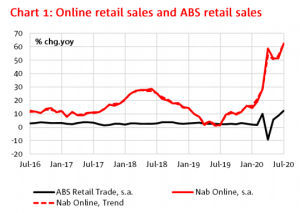

2020 has been a year like no other for ecommerce. More than ever, manufacturers and retailers are selling products via digital channels, with some Australian industry sectors seeing ecommerce growth close to 80% year on year (YOY). If you’re looking for sustainable long-term growth – ecommerce needs to be part of your business strategy.
By Haines Consulting Group founder and Managing Director Stuart Haines.
While many companies that have had to adapt their business to online platforms have seen huge sales growth, others have been left behind due to making a key mistake in their digital strategy – ignoring the customer experience.
The NAB Online Retail Sales Index 2020 report shows that online retail sales soared 62.6% year-on-year, led by an increase in online spending signifying a drastic change in consumer behaviour. NAB has estimated that Australians have spent A$37.4 billion on online retail in 12 months prior to July. As competition continues to increase for shopper attention, customer experience management becomes more and more important as part of the digital strategy.

Key to success: customer experience
Having a well-planned ecommerce strategy for your online business is vital to its ongoing success. The right strategy can propel your business to new heights, as goals are surpassed by higher aiming goals. It can position you as a leader in your niche – one that your competitors look up to with envy.
Customer experience is vital for ecommerce success – 70% of people make their decision to buy a product based on the experience. Companies needs to make a good first impression, with branded customised packaging that will increase the customer experience resulting in an increase of customer retention (returning customers).
Customer experience management is the practice of designing and reacting to customer interactions to meet or exceed their expectations, leading to greater customer satisfaction, loyalty, and advocacy.
The customer experience involves how a customer interacts with a company’s ecommerce website and the emotions it invokes. Just a few elements that allow you to maximise the customer experience on your website include:
- Knowing your customer
- Making your products easy to find
- Making your website user-friendly, clean and visually appealing
- Building great product pages
- Ensuring a simple and quick checkout process
- Identifying and remove any pain points in the shopping experience
- Educating your customer
- Optimising for mobile
- Responding quickly to any customer service inquiries
- Implementing competitive delivery costs and speed
- Designing impressive product packaging along with a thank you card for each delivery.
Making the customer experience an important part of your strategy is the best way to build brand loyalty, increase customer retention, and also benefit from customer referrals. It’s a great way to establish your ecommerce business as the leading brand in your niche.
Customer experience management is really about managing the end-to-end customer relationship across their entire journey with your brand — including all the different channels with which you choose to reach them. The customer experience is something that many businesses take for granted. You can use this to your advantage to dominate over the competition by creating an amazing online shopping experience that people won’t forget.
The customer experience is integral to your ecommerce strategy, creating a positive customer experience is critical for any ecommerce business growth.
Customer retention
An exceptional experience is key to giving ecommerce retailers a competitive advantage, as it is a differentiator that creates brand loyalty and reduces customer leakage. A study done by the Harvard Business School showed that increasing customer retention rates by only 5% can increase profits by up to 95%. Yet another study by Gartner estimated that 80% of a company’s future revenue will come from just 20% of existing customers
There are measurable benefits to creating an effective customer retention strategy:
- Acquisition costs: it can cost up to five times more to acquire a new customer than to retain a current customer.
- Lifetime value: by connecting with your customers emotionally, you can see customer lifetime values that are four times greater than without that personal touch.
- User experience: a solid customer experience can keep up to 84% of customers from leaving over something as simple as returning a product.
The success rate of selling to existing customers is 60–70%, compared to a 5–20% success rate with new customers. The major benefit of customer retention is that it is far more cost effective than acquisition. It can be up to five times more expensive to acquire a new customer than to retain the shoppers you already have.
You simply don’t have to invest as much money in advertising to an existing customer base. Instead, you can engage with them organically through your social media channels and use email marketing for regular touchpoints
Use these simple, yet effective tips to introduce ecommerce customer retention strategies to your marketing plan:
- Leverage your customer data: Email personalisation and list segmentation are effective tools for targeting your customers. You can use your customer data to find trends in your audience and their actions.
- Assess your marketing tools: Send-time optimisation and automated email campaigns are critical to effective customer retention. Determine how your current marketing tools can help you expand your campaigns.
- Determine your sales goals: Performance metrics can help drive future marketing efforts. Analyse your current sales goals and how your current marketing plan is performing before you decide the goals for your retention efforts.
Two basic ingredients combine in a successful ecommerce store; a constant stream of new customers, and a loyal core of regular customers. Businesses that focus entirely on customer acquisition lack the stability a loyal customer base provides. Those that focus entirely on keeping their current customers happy lose business to competitors and eventually to customer attrition over time.
The most successful businesses find a balance between the two.
About Stuart Haines
Stuart Haines is the founder and Managing Director of Haines Consulting Group and Haines Media, companies specialising in business growth, marketing and advertising. Stuart’s company was developed from his passion for working with innovative local entrepreneurs and helping them to grow their business ventures both nationally and internationally.
The post Business growth and the importance of customer experience appeared first on Retail World Magazine.
from Retail World Magazine https://ift.tt/3cOzDYK
via IFTTT
Comments
Post a Comment